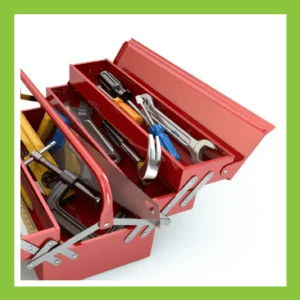Looking for help with garage door spring repair?
Garage doors use a spring system to counterbalance each side of the door so that it lifts evenly.
If the spring breaks, your garage door won’t open or close as designed. This can become a major headache when you need to be somewhere and can’t get your car out of the garage.
This guide will provide an overview of the different types of garage door springs and what garage door spring repair requires.
Here we go!
What are the garage door springs?
Springs make it easier to open and close your garage door. Without them garage doors would be extremely difficult to use; for most people, it would be impossible because they are so large and heavy.
Residential garage doors are equipped with one of two types of springs: extension or torsion.
Torsion Springs
Torsion springs are located above the door. They’re mounted on a metal rod parallel to the door. Pulleys attached to the bottom of that metal rod connected to the bottom of the door via cables.
When the door closes the pulley turns the rod to create tension in the spring. Opening the door releases that tension by unwinding the spring.
Torsion springs are usually guaranteed for three to seven years, or 30,000 times of opening and closing.
Extension Springs
Extension springs are mounted above the door’s horizontal tracks and run perpendicular to the door. They’re not mounted to a rod, rather, they’re suspended between two brackets. The length of the springs depending on how tall the door is.
When the door opens, the springs contract and tension are released causing the door to lift.
These springs are typically a lighter-gauge metal than torsion springs.
Why Garage Door Springs Fail
General wear-and-tear is the biggest reason springs fail. Your garage door is one of the most frequently used doors of the home. Because of this, its components are put under a lot of stress; eventually, the springs lose their capacity to compress and expand.
Added weight reduces the lifespan of garage door springs by placing extra stress on them. Things like windows and even paint can add weight to the door. Look for things like uneven gaps between the rings of the spring, bends, or excessive looseness; these are all signs that your spring is faulty.
Well-maintained springs can last up to thirty years. But lack of maintenance will contribute to their early failure. They need to be regularly inspected for things like loose tracks, damaged hinges and bearings, cracked springs, and adequate lubrication. Proper lubrication prevents rust that weakens the springs causing them to break.
Maintenance to the safety cable in extension springs is especially important. The safety cable keeps the spring from exploding pieces of metal in all directions. The cable should be smooth and free of frays.
What Can Go Wrong With Springs?
There are a variety of reasons that may cause garage door springs to fall into disrepair. In our experience, the following are the most common reasons.
Springs can become out of balance
Normally, garage doors can be opened with one hand from the middle of the door. The door opens smoothly. If you notice the door pulling on one side or won’t stay open where you want it then the springs are probably imbalanced. These can typically be adjusted rather than having to be replaced.
They’re too tight
When the springs are too tight you may notice that the door flies open. If you’ve got a garage door opener you may not notice it immediately, but the damage is still occurring. The electric gears of the opener have to work harder when the springs are tight which causes more wear and tear on the machine.
Springs are squeaky
Noisy springs may be disconcerting, and annoying, but they aren’t necessarily a sign of trouble. Before worrying, try using a spray-on lubricant to see if that resolves the issue.
There’s a problem with the brackets
Sometimes the problem with the door isn’t the spring, but the brackets at the bottom of the door. These, like the springs, are under a lot of pressure and should be adjusted with great care. Most newer models are tamper-resistant and can’t be accessed without a specialized too.
A Few Words of Caution
These springs can be very dangerous because they’re held under tension that holds a great deal of energy. Energy is released when the spring suddenly unwinds after a break or if it’s been improperly handled. Physical harm results regardless of how the tension is released.
For extension springs, make sure you have a safety cable installed to prevent the spring from flying apart if it does break. A safety cable is comprised of metal cording anchored to the wall or ceiling that runs through the garage door spring.
Before working on either type of spring ensure that all tension is released. It’s dangerous to work on a spring that is under pressure because that energy can be released quite violently, causing significant bodily harm.
Do It Yourself or Call A Professional?
If you have some do-it-yourself home improvement experience, you may be able to perform the garage door spring repair needed to fix your garage.
With that said, it’s a pretty big project so you may want to call in a garage door repair professional for help.
A professional will know exactly what parts are needed to repair your garage door spring, so you can rest assured you won’t have to spend a lot of time researching the available parts. In addition, a professional will be able to check for other potential problems while performing the repair.
Conclusion
Springs are an integral part of the garage door; without them, the door wouldn’t open properly.
Like other heavily used components, the springs can fail, sometimes without warning. Before undertaking repairs it’s a good idea to understand how the springs work, what to look for when they malfunction and acknowledge and implement some safety tips.

